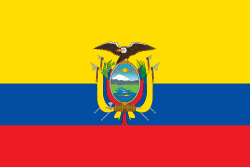Executive Secretary

XI International Scientific Conference on Agricultural Development and Sustainability
AGROCENTRO 2025
11st Symposium on Agronomy
Abstract
This study was conducted at the Manglaralto Support Center of UPSE with the aim of evaluating the effect of intercropping maize (Zea mays L.) with soybean (Glycine max), either inoculated or non-inoculated with nitrogen-fixing bacteria (NFB), on nitrogen availability and maize yield. A completely randomized block design (CRBD) was implemented, with seven treatments and three replications, including maize monoculture and maize-soybean associations under three nitrogen fertilization levels (100%, 75%, and 50%). Morphological and productive variables of both crops were evaluated, as well as nodulation in soybean. Results indicated that, although no statistically significant differences were found among treatments, the maize-soybean associations showed a positive trend in morphological and yield-related traits of maize. The highest grain yield was recorded in the maize monoculture (6.53 t/ha), followed by the association with inoculated soybean (6.12 t/ha). In the case of soybean, inoculation with NFB improved the number of pods per plant and root biomass, although nodulation was limited—possibly due to edaphoclimatic conditions or competition with native rhizobia. It is concluded that intercropping maize with soybean is an agronomically viable alternative that does not compromise maize yield and offers potential for promoting more sustainable agricultural systems. Further research is recommended to evaluate rhizobial strains adapted to local conditions and to improve management strategies in intercropping systems to enhance the development of both species.
Resumen
El presente estudio se desarrolló en el Centro de Apoyo Manglaralto de la UPSE con el objetivo de evaluar el efecto de la asociación entre el cultivo de maíz (Zea mays L.) y soya (Glycine max), inoculada y no inoculada con bacterias fijadoras de nitrógeno (BFN), sobre la disponibilidad de nitrógeno y el rendimiento del maíz. Se aplicó un diseño de bloques completamente al azar con siete tratamientos y tres repeticiones, incluyendo monocultivo de maíz y asociaciones con soya bajo tres niveles de fertilización nitrogenada (100%, 75% y 50%). Se evaluaron variables morfológicas y productivas de ambos cultivos, así como la nodulación en soya. Los resultados indicaron que, aunque no se registraron diferencias estadísticamente significativas entre tratamientos, las asociaciones con soya mostraron una tendencia positiva en variables morfológicas y productivas del maíz. El monocultivo presentó el mayor rendimiento (6,53 t/ha), seguido de la asociación con soya inoculada (6,12 t/ha). En el caso de la soya, la inoculación con BFN mejoró el número de vainas por planta y el peso de raíz, aunque la nodulación fue escasa, posiblemente por factores edafoclimáticos o competencia con rizobios nativos. Se concluye que la asociación de maíz con soya representa una alternativa agronómicamente viable, sin comprometer el rendimiento del maíz, y con potencial para avanzar hacia una agricultura más sostenible. Se recomienda evaluar cepas rizobianas adaptadas a la zona, así como mejorar las estrategias de manejo en cultivos asociados para potenciar el desarrollo de ambas especies.
About The Speaker

Dra. Mercedes Santistevan Méndez

Discussion

 Gold
Gold
 Gold
Gold
 Gold
Gold
 Gold
Gold
 Silver
Silver